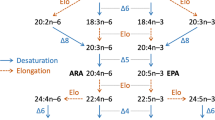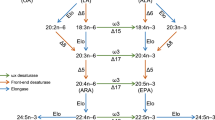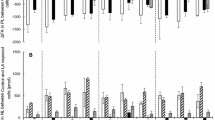Abstract
Long-chain (≥ C20) polyunsaturated fatty acids (LC-PUFA), such as eicosapentaenoic acid (20:5n-3, EPA) and docosahexaenoic acid (22:6n-3, DHA), are necessary for human health and are obtained from marine fish-derived oils. Marine fish are LC-PUFA-rich animals; however, many of them require LC-PUFA for growth. Therefore, it is suggested that they do not have sufficient ability to biosynthesize LC-PUFA. To evaluate in vivo LC-PUFA synthetic activity in fish cells, fish-derived cell lines from red sea bream (Pagrus major, PMS and PMF), Japanese flounder (Paralichthys olivaceus, HINAE), and zebrafish (Danio rerio, BRF41) were incubated with n-3 fatty acids labeled by radioisotopes or stable isotopes, and then, n-3 PUFA were analyzed by thin-layer chromatography or liquid chromatography-mass spectrometry. Labeled EPA and DHA were biosynthesized from labeled α-linolenic acid (18:3n-3) in BRF41, whereas they were not detected in PMS, PMF, or HINAE cells. We next cloned the fatty acid desaturase 2 (Fads2) cDNAs from PMF cells and zebrafish, expressed in budding yeasts, and then analyzed the substrate specificities of enzymes. As a result, we found that Fads2 from PMF cells was a ∆6/∆8 desaturase. Collectively, our study indicates that cell lines from red sea bream and Japanese flounder were not able to synthesize EPA or DHA by themselves, possibly due to the lack of ∆5 desaturase activity. Furthermore, this study provides a sensitive and reproducible non-radioactive method for evaluating LC-PUFA synthesis in fish cells using a stable isotope and liquid chromatography-mass spectrometry.





Similar content being viewed by others
Availability of Data and Material
All data not present in the manuscript is available upon request (correspondence to N.O., nokino@agr.kyushu-u.ac.jp).
References
Agaba M, Tocher DR, Dickson CA et al (2004) Zebrafish cDNA encoding multifunctional fatty acid elongase involved in production of eicosapentaenoic (20:5n–3) and docosahexaenoic (22:6n–3) acids. Mar Biotechnol 6:251–261
Brenner RR (1974) The oxidative desaturation of unsaturated fatty acids in animals. Mol Cell Biochem 3:41–52
Buzzi M, Henderson RJ, Sargent JR (1997) Biosynthesis of docosahexaenoic acid in trout hepatocytes proceeds via 24-carbon intermediates. Comp Biochem Physiol B Biochem Mol Biol 116:263–267
Calder PC (2014) Very long chain omega-3 (n-3) fatty acids and human health. Eur J Lipid Sci Technol 116:1280–1300
Carmona-Antoñanzas G, Monroig Ó, Dick JR et al (2011) Biosynthesis of very long-chain fatty acids (C>24) in Atlantic salmon: cloning, functional characterisation, and tissue distribution of an Elovl4 elongase. Comp Biochem Physiol B Biochem Mol Biol 159:122–129
Castro LFC, Tocher DR, Monroig O (2016) Long-chain polyunsaturated fatty acid biosynthesis in chordates: Insights into the evolution of Fads and Elovl gene repertoire. Prog Lipid Res 62:25–40
Dar AA, Choudhury AR, Kancharla PK, Arumugam N (2017) The FAD2 gene in plants: occurrence, regulation, and role. Front Plant Sci 8:1789
Datsomor AK, Zic N, Li K et al (2019) CRISPR/Cas9-mediated ablation of elovl2 in Atlantic salmon (Salmo salar L.) inhibits elongation of polyunsaturated fatty acids and induces Srebp-1 and target genes. Sci Rep 9:7533
Edgar RC (2004) MUSCLE: Multiple sequence alignment with high accuracy and high throughput. Nucleic Acids Res 32:1792–1797
Ferraz RB, Kabeya N, Lopes-Marques M et al (2019) A complete enzymatic capacity for long-chain polyunsaturated fatty acid biosynthesis is present in the Amazonian teleost tambaqui, Colossoma macropomum. Comp Biochem Physiol B Biochem Mol Biol 227:90–97
Fonseca-Madrigal J, Navarro JC, Hontoria F et al (2014) Diversification of substrate specificities in teleostei Fads2: characterization of ∆4 and ∆6∆5 desaturases of Chirostoma estor. J Lipid Res 55:1408–1419
Furuita H, Konishi K, Takeuchi T (1999) Effect of different levels of eicosapentaenoic acid and docosahexaenoic acid in Artemia nauplii on growth, survival and salinity tolerance of larvae of the Japanese flounder, Paralichthys olivaceus. Aquaculture 170:59–69
Garrido D, Kabeya N, Betancor MB et al (2019a) Functional diversification of teleost Fads2 fatty acyl desaturases occurs independently of the trophic level. Sci Rep 9:11199
Garrido D, Kabeya N, Hontoria F et al (2019b) Methyl-end desaturases with ∆12 and ω3 regioselectivities enable the de novo PUFA biosynthesis in the cephalopod Octopus vulgaris. Biochim Biophys Acta Mol Cell Biol Lipids 1864:1134–1144
Ghioni C, Tocher DR, Bell MV et al (1999) Low C18 to C20 fatty acid elongase activity and limited conversion of stearidonic acid, 18:4(n-3), to eicosapentaenoic acid, 20:5(n-3), in a cell line from the turbot, Scophthalmus maximus. Biochim Biophys Acta Mol Cell Biol Lipids 1437:170–181
Hamilton HA, Newton R, Auchterlonie NA, Müller DB (2020) Systems approach to quantify the global omega-3 fatty acid cycle. Nat Food 1:59–62
Hastings N, Agaba M, Tocher DR et al (2001) A vertebrate fatty acid desaturase with ∆5 and ∆6 activities. Proc Natl Acad Sci USA 98:14304–14309
Ishikawa A, Kabeya N, Ikeya K et al (2019) A key metabolic gene for recurrent freshwater colonization and radiation in fishes. Science 364:886–889
Janaranjani M, Mah MQ, Kuah MK et al (2018) Capacity for eicosapentaenoic acid and arachidonic acid biosynthesis in silver barb (Barbonymus gonionotus): functional characterisation of a Δ6/Δ8/Δ5 Fads2 desaturase and Elovl5 elongase. Aquaculture 497:469–486
Jin M, Monroig Ó, Navarro JC et al (2017) Molecular and functional characterisation of two elovl4 elongases involved in the biosynthesis of very long-chain (>C24) polyunsaturated fatty acids in black seabream Acanthopagrus schlegelii. Comp Biochem Physiol B Biochem Mol Biol 212:41–50
Jones DT, Taylor WR, Thornton JM (1992) The rapid generation of mutation data matrices from protein sequences. Bioinformatics 8:275–282
Kabeya N, Chiba M, Haga Y et al (2017) Cloning and functional characterization of fads2 desaturase and elovl5 elongase from Japanese flounder Paralichthys olivaceus. Comp Biochem Physiol B Biochem Mol Biol 214:36–46
Kabeya N, Fonseca MM, Ferrier DEK et al (2018) Genes for de novo biosynthesis of omega-3 polyunsaturated fatty acids are widespread in animals. Sci Adv 4:1–9
Kasai H, Yoshimizu M (2001) Establishment of two Japanese fIounder embryo cell lines. Bull Fish Sci Hokkaido Univ 52:67–70
Khozin-Goldberg I, Iskandarov U, Cohen Z (2011) LC-PUFA from photosynthetic microalgae: occurrence, biosynthesis, and prospects in biotechnology. Appl Microbiol Biotechnol 91:905–915
Kuah MK, Jaya-Ram A, Shu-Chien AC (2016) A fatty acyl desaturase (fads2) with dual Δ6 and Δ5 activities from the freshwater carnivorous striped snakehead Channa striata. Comp Biochem Physiol A Mol Integr Physiol 201:146–155
Kumar S, Stecher G, Li M et al (2018) MEGA X: Molecular evolutionary genetics analysis across computing platforms. Mol Biol Evol 35:1547–1549
Leibovitz A (1963) The growth and maintenance of tissue-cell cultures in free gas exchange with the atmosphere. Am J Epidemiol 78:173–180
Li Y, Monroig O, Zhang L et al (2010) Vertebrate fatty acyl desaturase with ∆4 activity. Proc Natl Acad Sci USA 107:16840–1684
Liu C, Ye D, Wang H et al (2020) Elovl2 but not Elovl5 is essential for the biosynthesis of docosahexaenoic acid (DHA) in zebrafish: insight from a comparative gene knockout study. Mar Biotechnol 22:613–619
Lopes-Marques M, Kabeya N, Qian Y et al (2018) Retention of fatty acyl desaturase 1 (fads1) in Elopomorpha and Cyclostomata provides novel insights into the evolution of long-chain polyunsaturated fatty acid biosynthesis in vertebrates. BMC Evol Biol 18:157
Machado AM, Tørresen OK, Kabeya N et al (2018) “Out of the can”: a draft genome assembly, liver transcriptome, and nutrigenomics of the European Sardine, Sardina pilchardus. Genes (basel) 9:1–13
Matsushita Y, Miyoshi K, Kabeya N et al (2020) Flatfishes colonised freshwater environments by acquisition of various DHA biosynthetic pathways. Commun Biol 3:1–9
Monroig Ó, Li Y, Tocher DR (2011) Delta-8 desaturation activity varies among fatty acyl desaturases of teleost fish: High activity in delta-6 desaturases of marine species. Comp Biochem Physiol B Biochem Mol Biol 159:206–213
Monroig O, Rotllant J, Cerdá-Reverter JM et al (2010) Expression and role of Elovl4 elongases in biosynthesis of very long-chain fatty acids during zebrafish Danio rerio early embryonic development. Biochim Biophys Acta Mol Cell Biol Lipids 1801:1145–1154
Monroig Ó, Rotllant J, Sánchez E et al (2009) Expression of long-chain polyunsaturated fatty acid (LC-PUFA) biosynthesis genes during zebrafish Danio rerio early embryogenesis. Biochim Biophys Acta Mol Cell Biol Lipids 1791:1093–1101
Oboh A, Kabeya N, Carmona-Antoñanzas G et al (2017) Two alternative pathways for docosahexaenoic acid (DHA, 22:6n–3) biosynthesis are widespread among teleost fish. Sci Rep 7:3889
Park HG, Park WJ, Kothapalli KSD, Brenna JT (2015) The fatty acid desaturase 2 (FADS2) gene product catalyzes Δ4 desaturation to yield n-3 docosahexaenoic acid and n-6 docosapentaenoic acid in human cells. FASEB J 29:3911–3919
Park WJ, Kothapalli KSD, Lawrence P et al (2009) An alternate pathway to long-chain polyunsaturates: the FADS2 gene product Δ8-desaturates 20:2n–6 and 20:3n–3. J Lipid Res 50:1195–1202
Pereira SL, Leonard AE, Mukerji P (2003) Recent advances in the study of fatty acid desaturases from animals and lower eukaryotes. Prostaglandins Leukot Essent Fat Acids 68:97–106
Sarker MA-A, Yamamoto Y, Haga Y et al (2011) Influences of low salinity and dietary fatty acids on fatty acid composition and fatty acid desaturase and elongase expression in red sea bream Pagrus major. Fish Sci 77:385–396
Sawayama E, Tanizawa S, Kitamura S et al (2017) Identification of quantitative trait loci for resistance to RSIVD in red sea bream (Pagrus major). Mar Biotechnol 19:601–613
Schiestl RH, Gietz RD (1989) High efficiency transformation of intact yeast cells using single stranded nucleic acids as a carrier. Curr Genet 16:339–346
Shulse CN, Allen EE (2011) Widespread occurrence of secondary lipid biosynthesis potential in microbial lineages. PLoS ONE 6:e20146
Sprecher H, Luthria DL, Mohammed BS, Baykousheva SP (1995) Reevaluation of the pathways for the biosynthesis of polyunsaturated fatty acids. J Lipid Res 36:2471–2477
Stroud CK, Nara TY, Roqueta-Rivera M et al (2009) Disruption of FADS2 gene in mice impairs male reproduction and causes dermal and intestinal ulceration. J Lipid Res 50:1870–1880
Swanson D, Block R, Mousa SA (2012) Omega-3 fatty acids EPA and DHA : health benefits throughout life. Adv Nutr 3:1–7
Takeuchi T, Toyota M, Satoh S, Watanabe T (1990) Requirement of juvenile red seabream Pagrus major for eicosapentaenoic and docosahexaenoic acids. Nippon Suisan Gakkaishi 56:1263–1269
Tocher DR (2010) Fatty acid requirements in ontogeny of marine and freshwater fish. Aquac Res 41:717–732
Tocher DR, Ghioni C (1999) Fatty acid metabolism in marine fish: low activity of fatty acyl Δ5 desaturation in gilthead sea bream (Sparus aurata) cells. Lipids 34:433–440
Zheng X, Ding Z, Xu Y et al (2009) Physiological roles of fatty acyl desaturases and elongases in marine fish: Characterisation of cDNAs of fatty acyl Δ6 desaturase and elovl5 elongase of cobia (Rachycentron canadum). Aquaculture 290:122–131
Acknowledgements
We thank Dr. Jun Kurita (National Research Institute of Aquaculture, Fisheries Research and Education Agency) for providing us the PMS and PMF cell lines. We are also grateful to Dr. Hisae Kasai (Faculty of Fisheries Sciences, Hokkaido University) who provided us the HINAE cell line.
Funding
This work was supported in part by the Sasakawa Scientific Research Grant from The Japan Science Society (to H.Y.).
Author information
Authors and Affiliations
Corresponding author
Ethics declarations
Conflict of Interest
The authors declare no competing interests.
Additional information
Publisher's Note
Springer Nature remains neutral with regard to jurisdictional claims in published maps and institutional affiliations.
Supplementary Information
Below is the link to the electronic supplementary material.
Rights and permissions
About this article
Cite this article
Nyunoya, H., Noda, T., Kawamoto, Y. et al. Lack of ∆5 Desaturase Activity Impairs EPA and DHA Synthesis in Fish Cells from Red Sea Bream and Japanese Flounder. Mar Biotechnol 23, 472–481 (2021). https://doi.org/10.1007/s10126-021-10040-9
Received:
Accepted:
Published:
Issue Date:
DOI: https://doi.org/10.1007/s10126-021-10040-9




